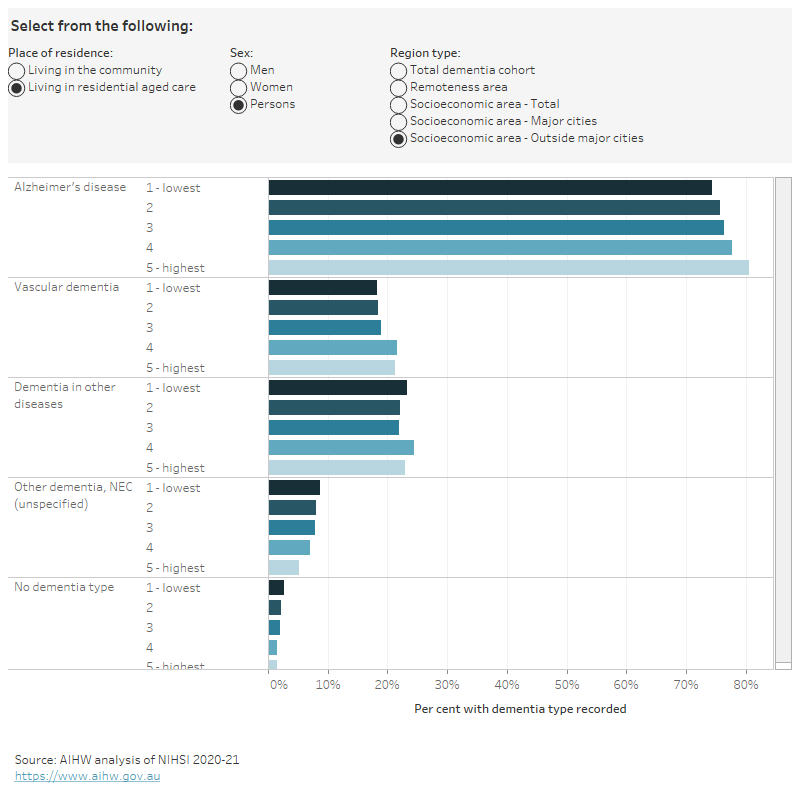Types of dementia
There are many types of dementia caused by a range of conditions impacting brain function. The most common types of dementia include Alzheimer’s disease, vascular dementia, dementia with Lewy bodies and frontotemporal dementia. It is common to have multiple types of dementia at once, known as ‘mixed dementia’ (see Understanding dementia for more information).
These are the 4 types of dementia shown in Figure 1.2: Alzheimer’s disease, Vascular dementia, Dementia in other diseases and Other dementia not elsewhere classified (NEC) or not otherwise specified (includes records of Unspecified dementia from other datasets).
However, caution should be taken when interpreting statistics by dementia type as coding for dementia type is inconsistent across the individual datasets in the linked data. Dementia types may also be misclassified in administrative data, or simply attributed to Unspecified dementia (Crowther et al. 2017; Waller et al. 2021). Further, due to complexities in diagnosing dementia and the possibility of a person having ‘mixed dementia’, multiple types of dementia may be recorded in a single administrative record as well as across records. Therefore, the number of dementia types will exceed the number of people living with dementia and the percentage of dementia types will sum to more than 100%.
People living in the community
- Alzheimer’s disease was the most common type of dementia recorded for people in the study cohort living in the community (59% of people), followed by Other dementia NEC (Unspecified dementia) (16% of people) and Dementia in other diseases (15% of people).
People living in residential aged care
- Alzheimer’s disease was the most common type of dementia recorded for people in the study cohort living in residential aged care (77% of people ),followed by Dementia in other diseases (24% of people) and Vascular dementia (20% of people). The hospital diagnosis of Delirium superimposed on dementia was the largest contributor to Dementia in other diseases.
For both groups
- women were more likely than men to have a record of Alzheimer’s disease
- men were more likely than women to have a record of Vascular dementia or Dementia in other diseases
- the percentage of people with a record of Other dementia NEC (Unspecified dementia) or with no dementia type recorded:
- increased with increasing socioeconomic disadvantage
- increased with increasing remoteness.
This may suggest poorer access to diagnostic methods that allow more specialised treatment and management.
Figure 1.2: Percentage of people with a type of dementia recorded in the linked data, by region of residence, place of residence and sex, 2010–2021
Figure 1.2 is an interactive bar chart showing that Alzheimer’s disease was the most common type of dementia recorded in the linked data. The percentage of people with an Alzheimer’s disease record decreased with increasing remoteness and socioeconomic disadvantage, while the percentage with a record of Other dementia NEC (Unspecified dementia) or with no dementia type recorded increased. This variation was more pronounced for people living in the community than for those living in residential aged care.

Notes
- The dementia study cohort refers to 158,730 people aged 30 and over who were living in Australia in 2019 and had a dementia record in the NIHSI. Western Australia and the Northern Territory were excluded from all analyses because their hospital data were not available for construction of the cohort.
- Dementia types were grouped under the 4 broad headings used in ACFI assessments: Alzheimer’s disease, Vascular dementia, Dementia in other diseases and Other dementia not elsewhere classified (NEC) or not otherwise specified (includes records of Unspecified dementia from other datasets).
- Dementia in other diseases includes: Frontotemporal dementia, Lewy Body dementia, Delirium superimposed on dementia, Dementia due to effect of substances, Dementia in Creutzfeldt-Jakob disease, Dementia in Huntington’s disease, Dementia in human immunodeficiency virus (HIV) disease, Dementia in other diseases.
- A dementia type of Alzheimer’s disease can be inferred through the dispensing of dementia-specific medications, which are currently only subsidised by the PBS/RPBS for people diagnosed with Alzheimer’s disease. This may inflate the percentage of people assigned a dementia type of Alzheimer’s disease, particularly those living in the community who are less likely to have a hospital, ACFI or death record.
- A record of a specific type of dementia took precedence over a record of Unspecified dementia or Other dementia NEC. If a person did not have a specific type of dementia identified in any record, they were assigned as having No dementia type.
- The bar is blank if a value could not be published due to data quality or confidentiality concerns.
Data table: Percentage of people with a type of dementia recorded
References
Crowther G, Bennett M and Holmes J (2017) How well are the diagnosis and symptoms of dementia recorded in older patients admitted to hospital?Age and Ageing, 46:1, doi:
Waller M, Buckley R, Masters C, Nona F, Eades S, Dobson A (2021) Deaths with Dementia in Indigenous and Non-Indigenous Australians: A Nationwide Study. Journal of Alzheimer's Disease, 81(4) 1589–1599.


